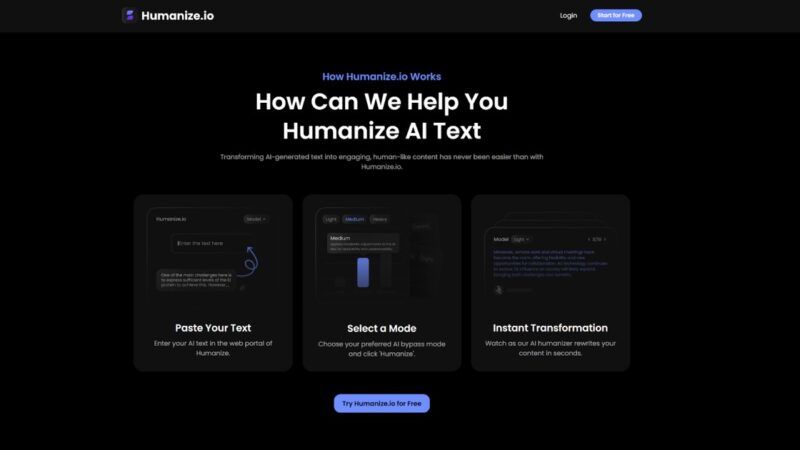AI-generated content often reads as flat, repetitive, or formulaic—making it susceptible to AI-detectors like GPTZero, Originality.ai, Turnitin, and Copyleaks. While AI excels at producing drafts, tools like Humanize.io help humanize these drafts by adding natural variation, flow, and subtle imperfections—critical traits for evading detection.
According to Humanize.io, its technology mimics “real human writers” and delivers up to a 99% success rate in bypassing leading detectors. However, independent studies caution that advanced detectors still flag paraphrased content. Awareness of these limitations is key.
Table of Contents
Step‑by‑Step Workflow
Step 1: Generate AI Draft
Use your preferred AI writer (ChatGPT, Claude, Bard, etc.) to produce the initial draft. Aim for clear, coherent structure and include your target keywords.
Step 2: Segment the Text
Break the draft into manageable chunks (300–500 words each). Smaller segments allow finer control and more natural rewriting.
Step 3: Paste & Select Mode
Open Humanize.io, paste the first segment, and choose a mode:
- Light/Standard: Minor tweaks; ideal for short text.
- Heavy/Advanced: Deep paraphrasing; suited for longer sections.
These modes manipulate tone, sentence structure, punctuation, and idioms.
Step 4: Click “Humanize”
The tool rewrites each segment in seconds, producing a more varied, human-like version.
Step 5: Check Detector Scores
Review built-in detector results from GPTZero, Copyleaks, Winston AI, etc. Aim for <20% AI score—but don’t rely solely on these results.
Step 6: Iterate If Needed
If scores remain high, re-run the segment in a deeper mode or run through again. Most tools let you iterate without limits.
Step 7: Manual Polish
Read the output aloud to catch meaning drift, tone inconsistencies, or awkward phrasing. Manual adjustments help restore clarity and prevent disjointedness noted in heavy paraphrases.
Step 8: Consolidate Segments
Combine polished segments. Ensure transitions feel smooth, key terms are retained for SEO, and tone remains consistent.
Step 9: Final AI‑Detection Test
Run the full text through the exact detector your recipient uses (e.g., Originality.ai for academic submissions). Even if Humanize.io results look clean, independent testing shows that advanced detectors can still flag paraphrased content.
Step 10: Use Reinforcement Techniques
To further mask AI’s fingerprint, you can:
- Inject small errors or stylistic quirks (though too many may trigger manual suspicion).
- Apply adversarial paraphrasing techniques, drawing on research like AuthorMist (reinforcement learning can lower detection by >78%).
- Use in-context prompt-guiding techniques (e.g., SICO prompts) that have been shown to reduce detector accuracy.
These advanced approaches complement, rather than replace, Humanize.io’s capabilities.

Understanding Effectiveness & Limitations
What Works
- Basic detectors based on lexical patterns (GPTZero, Writer) are often fooled by paraphrasing and varied syntax.
- Humanized tone and variety significantly reduce AI detection—especially when paired with keyword retention and manual edits.
What Doesn’t
- Fingerprinting detectors (Originality.ai, retrieval-based systems) still flag humanized content in many cases.
- Although reinforcement-trained models like AuthorMist reduce detectability by up to 96%, their implementation is nontrivial compared to Humanize.io.
Best Practices for Undetectability
- Keep human tone natural: Don’t over-correct; slight redundancies and idiomatic phrases help.
- Maintain semantic integrity: Heavy paraphrasing can drift meaning. Always verify.
- Run the target detector early: Know what you’re up against.
- Iterate selectively: Use Light/Standard for short passages; escalate only when needed.
- Combine tools: Consider a layered approach with Humanize.io, manual edits, and possibly reinforcement-guided models.
- Stay ethical: Use tactics responsibly—misrepresentation in academic or regulated contexts risks serious consequences.
Ethical & Compliance Considerations
Tools like Humanize.io raise ethical questions. Auto-refining content isn’t inherently unethical—especially in marketing or personal blogs. However, deliberately masking AI usage where disclosure is required (academia, legal, journalism) is problematic.
- Be transparent when institutional or regulatory rules demand it.
- Use humanization to improve clarity, not deceive.
- Understand that detection tools continually evolve to flag paraphrasing patterns.
Summary Table
| Step | Action | Goal |
| 1 | Generate AI draft | Structured initial content |
| 2 | Segment draft | Incremental control |
| 3 | Humanize each segment | Add natural variation |
| 4 | Check detector scores | Evaluate progress |
| 5 | Iterate or manual polish | Improve readability & accuracy |
| 6 | Combine and finalize | Seamless flow and SEO optimization |
| 7 | Final detector test | Ensure bypass against target tools |
| 8 | Optional reinforcement techniques | Improve undetectability further |
| 9 | Ethical check | Assess fairness, disclosure needs |
Final Takeaway
Humanize.io is a powerful step for turning AI drafts into natural, engaging content. Its built-in modes and detector scores simplify the humanization process, allowing users to fine-tune effectively. Paired with manual editing, it can evade basic detection tools impressively.
However, advanced detection systems still pose a risk, and true “undetectability” requires layered approaches—including reinforcement-based paraphrasing or prompt-level evasion. Awareness, iteration, and responsible use are key to success.

Andrej Fedek is the creator and the one-person owner of two blogs: InterCool Studio and CareersMomentum. As an experienced marketer, he is driven by turning leads into customers with White Hat SEO techniques. Besides being a boss, he is a real team player with a great sense of equality.
